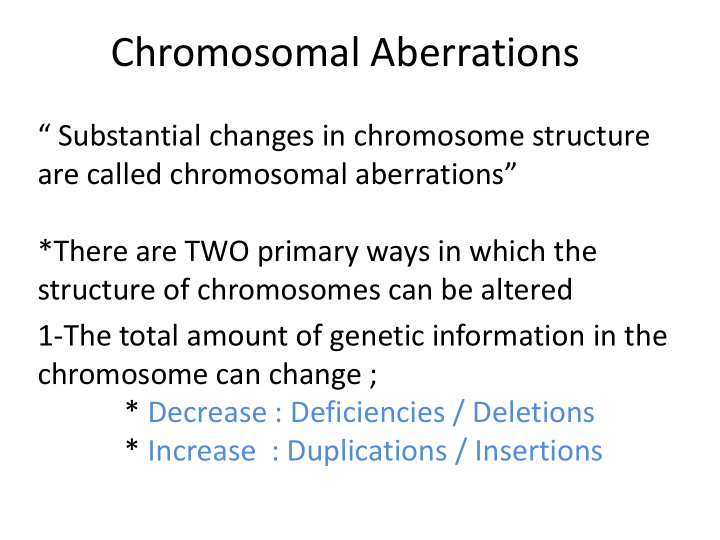



Chromosomal Aberrations “ Substantial changes in chromosome structure are called chromosomal aberrations” *There are TWO primary ways in which the structure of chromosomes can be altered 1-The total amount of genetic information in the chromosome can change ; * Decrease : Deficiencies / Deletions * Increase : Duplications / Insertions
Chromosomal Aberrations 2-The genetic material may remain the same , but is rearranged; * Inversions *Translocations Alterations in Chromosome structure -Deletion : Loss of a chromosomal segment . - Duplication : Repetition of a chromosomal segment . - Inversion : A change in the direction of genetic material along a single chromosome.
Chromosomal Aberrations - Translocation : A segment of one • chromosome becomes attached to a non homologous chromosome * Simple Translocations - one way transfer * Reciprocal Translocations - Two way transfer
Deletions Part of chromosome is missing - -Causes Of Deletions * Heat or Radiation ( especially ionization) * Chemicals * Viruses * Errors in recombination -Deletions do not revert - because the DNA is degraded
Deletions -Loss of several genes can cause lethal consequences ; FOR EXAMPLE , -Human disorders caused by large chromosomal deletions -Cry-du-chat (cry of the cat ) syndrome resulting from deletion of part of the short arm of chromosome 5. -The deletion results in several mental retardation and physical abnormalities , For Example ,Microcephaly
Duplications -Duplications result from doubling of chromosomal segments , and occur in a range of sizes and locations .
Duplication -Tandem Duplications are adjacent to each other. -Reverse Tandem Duplicat- ions result in genes arranged In opposite order of the original. -Tandem duplication at the end of chromosome is a Terminal tandem duplication .
Inversions -Inversions results when a chromosomal segment excises and reintegrates , oriented 180 degree from the original orientation .
Inversion • *In an Inversion , the total amount of genetic information stays the same. • - Therefore ,the great majority of inversions have no phenotypic consequences • * In rare cases, inversions can alter the phenotype of an individual, - Break point effect : • -The breaks leading to the inversions occur in a vital gene •
Inversions • - Position effect : • - A gene is repositioned in a way that alters its gene expression • - About 2 % of the human population carries inversions that are detectable with a light microscope. • - most of these individuals are phenotypically normal • -However , a few produce offspring with genetic abnormalities
Translocations • -Translocation occurs when a segment of one chromosome becomes attached to another. -There are two main types of translocations ; *Reciprocal (balanced) translocations *Robertsonian(unbalanced) translocations -Both types of translocations can cause disease in humans.
Translocations
Reciprocal Translocations -In Reciprocal translocations two non-homologous Chromosomes exchange genetic material. - Reciprocal translocation arise from two different mechanisms ; 1- chromosomal breakage and DNA repair 2-Abnormal crossovers - Reciprocal translocations lead to the re- arrangement of the genetic material, -not a change in the total amount -thus , they are also called balanced translocations
Robertsonian Translocations • -In Robertsonian translocations the transfer of genetic material occurs in only one direction. -Robertsonian translocations are associated with phenotypic abnormalities or even lethality. -EXAMPLE :Familial Down Syndrome -in this condition , the majority of chromosome 21 is attached to chromosome 14 . -The individual would have three copies of genes found on a large segment of chromosome 21
Robertsonian Translocations • -Robertsonian translocations are confined to chromosomes 13 , 14 , 15 , 21 -Acrocentric Chromosomes
Recommend
More recommend